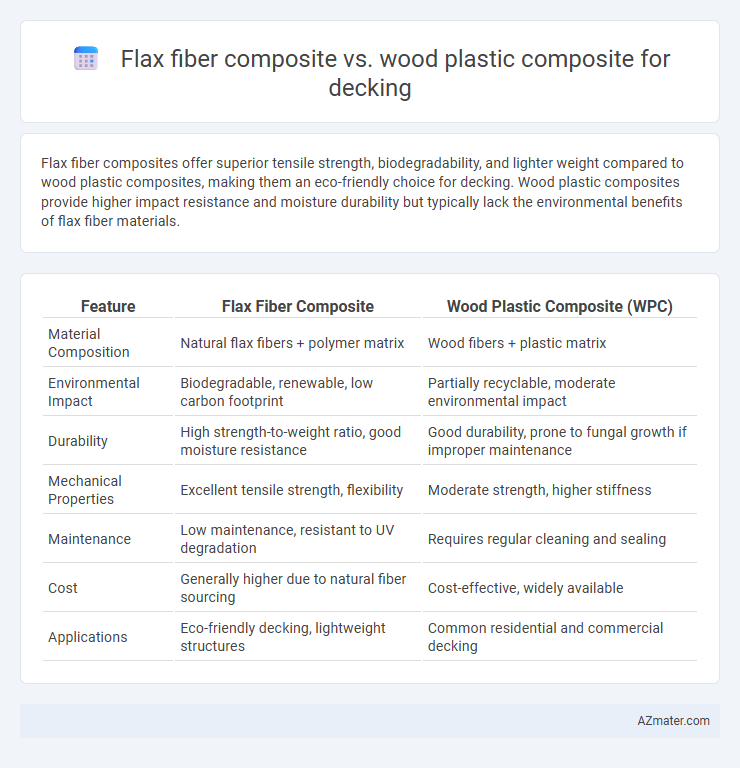Flax fiber composites offer superior tensile strength, biodegradability, and lighter weight compared to wood plastic composites, making them an eco-friendly choice for decking. Wood plastic composites provide higher impact resistance and moisture durability but typically lack the environmental benefits of flax fiber materials.
Table of Comparison
| Feature | Flax Fiber Composite | Wood Plastic Composite (WPC) |
|---|---|---|
| Material Composition | Natural flax fibers + polymer matrix | Wood fibers + plastic matrix |
| Environmental Impact | Biodegradable, renewable, low carbon footprint | Partially recyclable, moderate environmental impact |
| Durability | High strength-to-weight ratio, good moisture resistance | Good durability, prone to fungal growth if improper maintenance |
| Mechanical Properties | Excellent tensile strength, flexibility | Moderate strength, higher stiffness |
| Maintenance | Low maintenance, resistant to UV degradation | Requires regular cleaning and sealing |
| Cost | Generally higher due to natural fiber sourcing | Cost-effective, widely available |
| Applications | Eco-friendly decking, lightweight structures | Common residential and commercial decking |
Introduction to Sustainable Decking Materials
Flax fiber composite and wood plastic composite are innovative materials gaining attention in sustainable decking due to their eco-friendly properties. Flax fiber composites use natural plant fibers combined with bio-based resins, resulting in lightweight, strong, and biodegradable decking solutions. Wood plastic composites blend recycled wood fibers and plastic, offering durability and resistance to moisture while promoting the reuse of waste materials in outdoor construction.
Overview of Flax Fiber Composites
Flax fiber composites exhibit a high strength-to-weight ratio and enhanced environmental sustainability compared to traditional wood plastic composites (WPC), making them a superior choice for decking applications. These composites combine natural flax fibers with bio-based or synthetic resins, offering excellent mechanical properties, biodegradability, and lower carbon footprint. The superior moisture resistance and durability of flax fiber composites contribute to longer-lasting, eco-friendly decking materials with reduced maintenance demands.
Understanding Wood Plastic Composites (WPC)
Wood Plastic Composites (WPC) combine wood fibers or flour with thermoplastics like polyethylene, polypropylene, or PVC to enhance durability and resistance against moisture, rot, and insects, making them ideal for decking applications. Their manufacturing process involves blending these materials under heat and pressure, resulting in a composite that offers a wood-like appearance with reduced maintenance compared to traditional wood. Key factors such as moisture resistance, mechanical strength, and environmental impact position WPC as a versatile and sustainable decking option over conventional materials.
Mechanical Properties: Flax Fiber vs WPC
Flax fiber composites exhibit higher tensile strength and stiffness compared to wood plastic composites (WPC), making them more suitable for load-bearing decking applications. The natural fibers in flax composites provide superior impact resistance and fatigue durability, enhancing long-term structural integrity. In contrast, WPC materials typically offer better moisture resistance but lower mechanical performance under dynamic loads.
Environmental Impact and Sustainability Comparison
Flax fiber composites outperform wood plastic composites in environmental impact due to their renewable, biodegradable flax fibers that reduce carbon footprint and dependency on fossil fuels. Wood plastic composites rely heavily on non-renewable plastics, leading to greater microplastic pollution and recycling challenges. Sustainable sourcing of flax combined with lower energy consumption during production makes flax fiber composites a greener alternative for eco-friendly decking solutions.
Durability and Weather Resistance
Flax fiber composites exhibit superior durability and weather resistance compared to wood plastic composites (WPC) due to their enhanced resistance to moisture absorption and UV degradation, which reduces warping and splintering over time. The natural lignin and cellulose structure in flax fibers provides greater mechanical strength and flexibility, allowing decks to withstand temperature fluctuations and heavy-use conditions with minimal deterioration. In contrast, WPCs often suffer from susceptibility to fungal growth and surface fading, requiring more frequent maintenance to preserve structural integrity and aesthetic appearance.
Aesthetics and Design Flexibility
Flax fiber composites offer a natural, warm appearance with fine textures that closely resemble traditional wood, enhancing the visual appeal of decking surfaces. These composites allow greater design flexibility due to their lightweight nature and ability to be molded into intricate shapes, enabling customized patterns and finishes. Wood plastic composites (WPC) provide consistent grain textures but often lack the rich, organic aesthetics and design versatility found in flax fiber alternatives.
Installation and Maintenance Requirements
Flax fiber composites offer lighter weight and easier cutting compared to wood plastic composites (WPC), enabling faster installation with standard woodworking tools. Flax fiber decks require less frequent sealing and are more resistant to moisture-related warping, reducing ongoing maintenance efforts. WPC, while durable, often demands specialized fasteners and periodic cleaning to prevent mold and surface degradation.
Cost Analysis: Flax Fiber Composite vs WPC
Flax fiber composite decking generally offers a lower overall cost compared to wood plastic composite (WPC) due to its renewable raw materials and energy-efficient manufacturing process. The initial material expense for flax fiber composites is typically reduced by 10-20%, while maintenance costs remain minimal because of their natural resistance to moisture and UV degradation. Long-term financial benefits are enhanced by flax composites' superior durability, which decreases replacement frequency and lifecycle expenses relative to traditional WPC decking.
Future Trends in Decking Materials
Flax fiber composite decking offers a sustainable alternative to traditional wood plastic composite (WPC) by combining natural fibers with polymer matrices, enhancing strength and reducing environmental impact. Emerging trends in decking materials emphasize bio-based composites like flax fiber for improved durability, moisture resistance, and eco-friendliness compared to conventional WPC, which often rely heavily on synthetic plastics. Advances in processing technologies and fiber treatments are expected to further optimize the mechanical properties and lifespan of flax fiber composites, positioning them as a leading choice in the future decking market.

Infographic: Flax fiber composite vs Wood plastic composite for Decking
 azmater.com
azmater.com